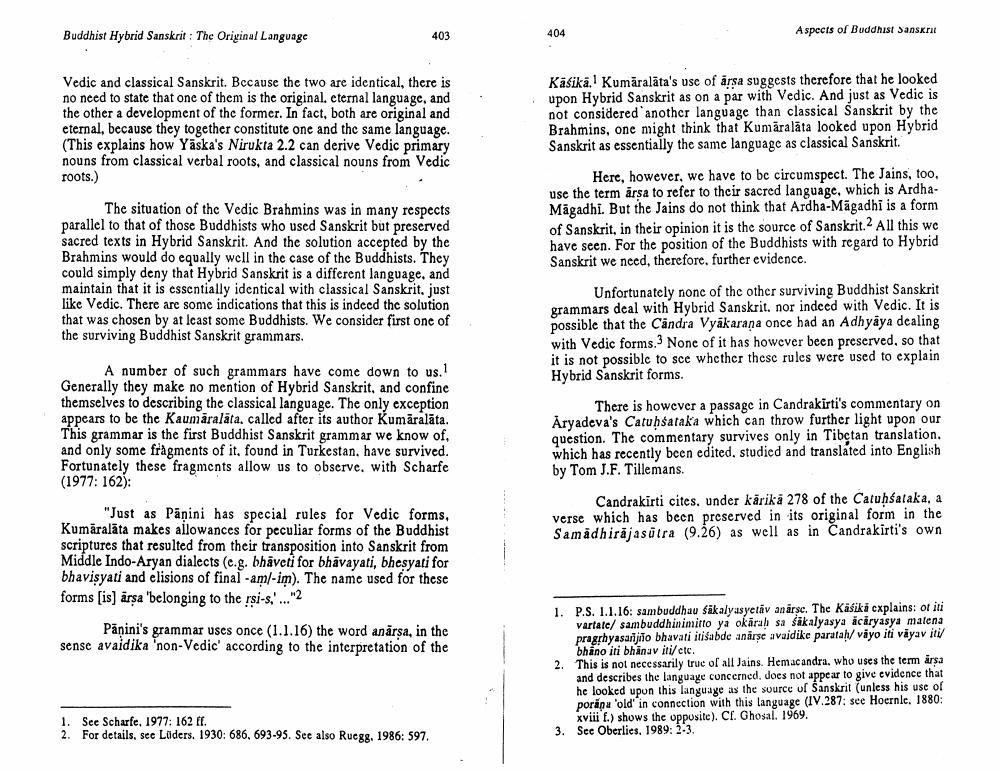________________
Buddhist Hybrid Sanskrit: The Original Language
Aspects of Buddhist Sanskrit
403
Vedic and classical Sanskrit. Because the two are identical, there is no need to state that one of them is the original, eternal language, and the other a development of the former. In fact, both are original and eternal, because they together constitute one and the same language. (This explains how Yaska's Nirukta 2.2 can derive Vedic primary nouns from classical verbal roots, and classical nouns from Vedic roots.)
Käsikä. Kumāralata's use of arsa suggests therefore that he looked upon Hybrid Sanskrit as on a par with Vedic. And just as Vedic is not considered another language than classical Sanskrit by the Brahmins, one might think that Kumaraláta looked upon Hybrid Sanskrit as essentially the same language as classical Sanskrit.
Here, however, we have to be circumspect. The Jains, too, use the term årsa to refer to their sacred language, which is ArdhaMàgadhi. But the Jains do not think that Ardha-Magadhi is a form of Sanskrit, in their opinion it is the source of Sanskrit. All this we have seen. For the position of the Buddhists with regard to Hybrid Sanskrit we need, therefore, further evidence.
The situation of the Vedic Brahmins was in many respects parallel to that of those Buddhists who used Sanskrit but preserved sacred texts in Hybrid Sanskrit. And the solution accepted by the Brahmins would do equally well in the case of the Buddhists. They could simply deny that Hybrid Sanskrit is a different language, and maintain that it is essentially identical with classical Sanskrit, just like Vedic. There are some indications that this is indeed the solution that was chosen by at least some Buddhists. We consider first one of the surviving Buddhist Sanskrit grammars.
Unfortunately none of the other surviving Buddhist Sanskrit grammars deal with Hybrid Sanskrit. nor indeed with Vedic. It is possible that the Candra Vyakarana once had an Adhyâya dealing with Vedic forms. None of it has however been preserved, so that it is not possible to sce whether these rules were used to explain Hybrid Sanskrit forms.
A number of such grammars have come down to us. Generally they make no mention of Hybrid Sanskrit, and confine themselves to describing the classical language. The only exception appears to be the Kaumaraláta. called after its author Kumaraláta. This grammar is the first Buddhist Sanskrit grammar we know of, and only some fragments of it, found in Turkestan, have survived. Fortunately these fragments allow us to observe, with Scharfe (1977: 162):
There is however a passage in Candrakirti's commentary on Aryadeva's Catuhsataka which can throw further light upon our question. The commentary survives only in Tibetan translation, which has recently been edited, studied and translated into English by Tom J.F. Tillemans.
Candrakirti cites. under kärikå 278 of the Catuhśataka, a verse which has been preserved in its original form in the Samadhirajasūtra (9.26) as well as in Candrakirti's own
"Just as Panini has special rules for Vedic forms, Kumaraläta makes allowances for peculiar forms of the Buddhist scriptures that resulted from their transposition into Sanskrit from Middle Indo-Aryan dialects (c.g. bhäveti for bhavayati, bhesyati for bhavisyati and elisions of final -am/-im). The name used for these forms [is] årsa 'belonging to the rşi-s,'... 2
Panini's grammar uses once (1.1.16) the word anårsa, in the sense avaidika 'non-Vedic' according to the interpretation of the
1. P.S. 1.1.16: sambuddhau fikalyasyetáv anárse. The Kafiki explains: oriti
vartate/ sambuddhinimitto ya okárah sa fikalyasya iciryasya matena praghyasanjo bhavati itisabde anárse avaidike paratal viyo iti viyaviti
bhano iti bhänav iti/ctc. 2. This is not necessarily truc of all Jains. Hemacandra, who uses the term arsa
and describes the language concerned, does not appear to give evidence that he looked upon this language as the source of Sanskrit (unless his use of por pa 'old' in connection with this language (IV.287: see Hoernlc. 1880:
xviii f.) shows the opposite). CI. Ghosal. 1969. 3. Sec Oberlies. 1989: 2-3.
1. See Scharfe, 1977: 162 ff. 2. For details, see Lüders. 1930: 686, 693-95. See also Ruegg. 1986: 597.




